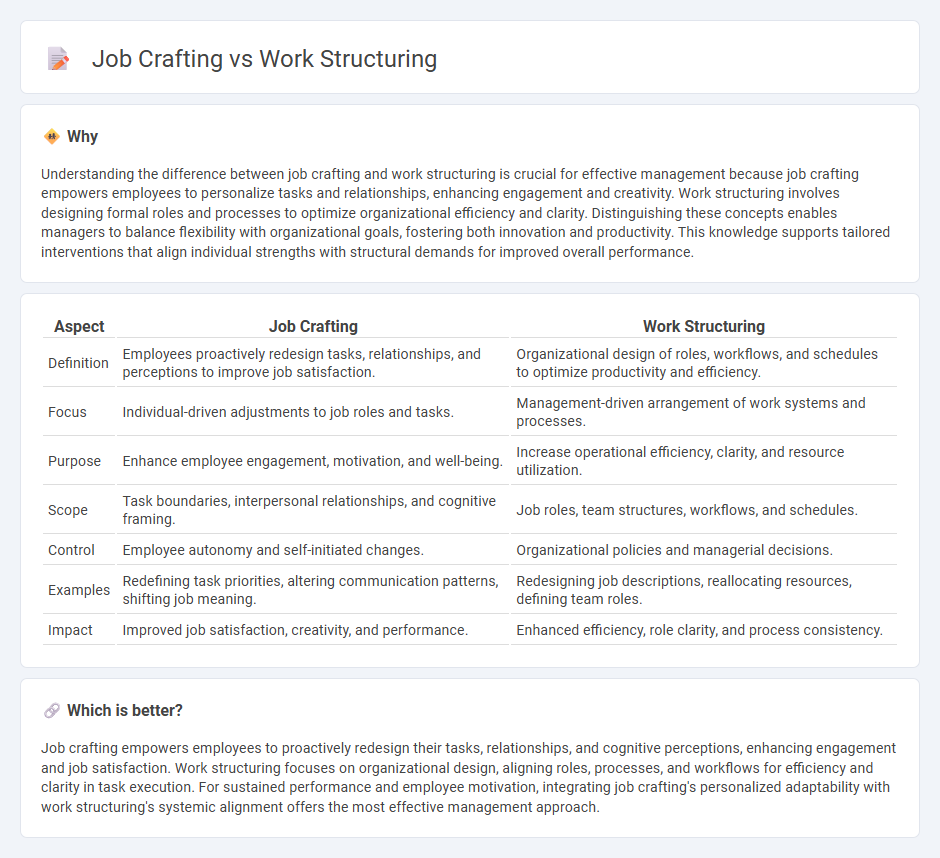
Job crafting involves employees proactively redesigning their tasks and interactions to better fit their skills and interests, enhancing job satisfaction and performance. Work structuring focuses on how organizations allocate tasks, roles, and workflows to optimize efficiency and productivity. Discover the distinct impact of job crafting and work structuring on effective management.
Why it is important
Understanding the difference between job crafting and work structuring is crucial for effective management because job crafting empowers employees to personalize tasks and relationships, enhancing engagement and creativity. Work structuring involves designing formal roles and processes to optimize organizational efficiency and clarity. Distinguishing these concepts enables managers to balance flexibility with organizational goals, fostering both innovation and productivity. This knowledge supports tailored interventions that align individual strengths with structural demands for improved overall performance.
Comparison Table
| Aspect | Job Crafting | Work Structuring |
|---|---|---|
| Definition | Employees proactively redesign tasks, relationships, and perceptions to improve job satisfaction. | Organizational design of roles, workflows, and schedules to optimize productivity and efficiency. |
| Focus | Individual-driven adjustments to job roles and tasks. | Management-driven arrangement of work systems and processes. |
| Purpose | Enhance employee engagement, motivation, and well-being. | Increase operational efficiency, clarity, and resource utilization. |
| Scope | Task boundaries, interpersonal relationships, and cognitive framing. | Job roles, team structures, workflows, and schedules. |
| Control | Employee autonomy and self-initiated changes. | Organizational policies and managerial decisions. |
| Examples | Redefining task priorities, altering communication patterns, shifting job meaning. | Redesigning job descriptions, reallocating resources, defining team roles. |
| Impact | Improved job satisfaction, creativity, and performance. | Enhanced efficiency, role clarity, and process consistency. |
Which is better?
Job crafting empowers employees to proactively redesign their tasks, relationships, and cognitive perceptions, enhancing engagement and job satisfaction. Work structuring focuses on organizational design, aligning roles, processes, and workflows for efficiency and clarity in task execution. For sustained performance and employee motivation, integrating job crafting's personalized adaptability with work structuring's systemic alignment offers the most effective management approach.
Connection
Job crafting and work structuring are interconnected as both involve the proactive redesign of job roles to enhance employee engagement and productivity. Job crafting allows employees to tailor their tasks, relationships, and perceptions, aligning personal strengths with organizational goals, while work structuring focuses on arranging tasks, responsibilities, and workflows systematically within the organization. Together, these practices optimize job performance and satisfaction by creating a work environment that adapts to individual capabilities and strategic objectives.
Key Terms
Task Allocation
Work structuring involves systematically organizing tasks and responsibilities within an organization to optimize efficiency and clarity in task allocation. Job crafting, by contrast, empowers employees to redefine and personalize their task allocation by altering job boundaries, relationships, and cognitive perceptions to enhance engagement and satisfaction. Discover how aligning structured task allocation with job crafting strategies can transform workplace productivity and employee fulfillment.
Employee Autonomy
Work structuring involves designing job roles and responsibilities at an organizational level to enhance efficiency and clarity, whereas job crafting empowers employees to modify their tasks and interactions to better align with personal strengths and interests, boosting autonomy. Employee autonomy increases significantly through job crafting as individuals tailor their work environment and processes, fostering motivation and job satisfaction. Explore how leveraging both approaches can maximize employee autonomy and drive organizational success.
Role Design
Work structuring involves organizing tasks and responsibilities within a role to optimize efficiency and alignment with organizational goals. Job crafting, by contrast, empowers individuals to customize their roles by reshaping tasks, relationships, and perceptions to increase engagement and job satisfaction. Explore more about role design strategies that balance organizational needs with employee autonomy to enhance performance.
Source and External Links
Work Structuring - Landmark Consulting - Work Structuring is a bottom-up, process-based methodology that optimizes organizational structures by starting from key processes that define an organization's purpose, applicable across manufacturing and service sectors.
Work breakdown structures overview - Microsoft Docs - A Work Breakdown Structure (WBS) is a hierarchical decomposition of project tasks designed to describe, schedule, and estimate costs, tailored to project type and required detail level.
Work breakdown structure - Wikipedia - In project management, a WBS is a key element breaking a project into smaller, manageable components to support cost estimation, scheduling, and scope control through progressive elaboration.
 dowidth.com
dowidth.com